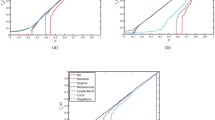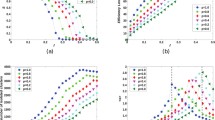Abstract
The issue about cascading failures of interdependent networks is a hot research field based on the current complex network basic theories. This paper mainly researches methods for improving robustness of interdependent networks. At first, a model of interdependent network cascading failures was established to carry out robustness analysis of three different interdependent networks including BA–BA, WS–WS and ER–ER. Then, methods for improving robustness of interdependent networks under random attacks and targeted attacks were researched respectively. (1)Under random attacks, based on the overall idea of network addition, the paper summarized four common methods for improving robustness of a simple complex network, including random addition, low-degree node addition, low-betweenness node addition and addition based on algebra connectivity. After that, according to inherent characteristics of interdependent networks, the paper put forward an interdependent network addition algorithm based on internal similarities. It is shown in cascading failure simulation calculation results of three interdependent coupling networks, that the method put forward in this paper can most effectively improve robustness of interdependent networks under random attacks. (2)Based on the overall idea of protecting key nodes under targeted attacks, the paper put forward a method for analyzing key nodes of interdependent networks based on natural connectivity. Then, under the BA–BA interdependent network, the paper analyzed this method in comparison with the commonly approved Max-Cas algorithm. It is shown in simulation calculation results that, the method put forward in this paper can more obviously improve robustness of an interdependent network under targeted attacks and can be applied flexibly.





Similar content being viewed by others
References
Li, L., Xiao, J., Peng, H., Yang, Y., & Chen, Y. (2012). Improving synchronous ability between complex networks. Nonlinear Dynamics, 69, 1105–1110.
Wang, W., Li, L., Peng, H., Xiao, J., & Yang, Y. (2014). Stochastic synchronization of complex network via a novel adaptive nonlinear controller. Nonlinear Dynamics, 76, 591–598.
Wang, K., Zhang, B., Zhang, H. Z., Yin, X. G., & Wang, B. (2011). An electrical betweenness approach for vulnerability assessment of power grids considering the capacity of generators and load. Physica A, 390, 4692–4701.
Buldyrev, S. V., Parshani, R., Paul, G., Stanley, H. E., & Havlin, S. (2010). Catastrophic cascade of failures in interdependent networks. Nature, 464, 1025–1028.
Lü, L., Yu, M., Li, C., Liu, S., Yan, B., Chang, H., et al. (2013). Projective synchronization of a class of complex network based on high-order sliding mode control. Nonlinear Dynamics, 73, 411–416.
Wang, J. W., Yun, L., & Zheng, Q. F. (2014). Cascading load model in interdependent networks with coupled strength. Physica A, 430, 242–253.
Sydney, A., Scoglio, C., & Gruenbacher, D. (2013). Optimizing algebraic connectivity by edge rewiring. Applied Mathematics and Computation, 219, 5465–5479.
Ji, X., Wang, B., Liu, D., Guo, C., Tang, F., Wei, D., et al. (2016). Improving interdependent networks robustness by adding connectivity links. Physica A, 444, 9–16.
Peng, X. Z., Yao, H., Du, J., Wang, Z., & Ding, C. (2015). Load-induced cascading failure in interdependent network. Acta Physica Sinica, 64(4), 048901.
Wang, J. W., & Rong, L. L. (2011). Robustness of the western United States power grid under edge attack strategies due to cascading failures. Safety Science, 49(6), 807–812.
Cohen, R., Erez, K. D., Avraham, B., & Havlin, S. (2001). Breakdown of the internet under intentional attack. Physical Review Letters, 86(16), 3682–3685.
Gao, J., Buldyrev, S. V., Stanley, H., & Havlin, E. S. (2012). Networks formed from interdependent networks. Nature Physics, 8(1), 40–48.
Watts, D. J., & Strogatz, S. H. (1998). Co1lective dynamics of small-world networks. Nature, 393(6684), 440–442.
Barabasi, A. L., & Albert, R. (1999). Emergence of scaling in random networks. Science, 286(5439), 509–512.
Ruj, S., & Pal, A. (2014). In 28th International conference on advanced information networking and applications, Victoria, BC, Canada.
Liu, R. R., Jia, C. X., Zhang, J. L., & Wang, B. H. (2012). Robustness of interdependent networks under several intentional attack strategies. Journal of University of Shanghai for Science and Technology, 34(3), 235–239.
Nguyen, D. T., Shen, Y., & Thai, M. T. (2013). Detecting critical nodes in interdependent power networks for vulnerability assessment. IEEE Transactions on Smart Grid, 4, 151–159.
Sen, A., Mazumder, A., Banerjee, J., & Das, A. (2014). Identification of K most vulnerable nodes in multi-layered network using a new model of interdependency, Compton R 2014. In Proceedings of IEEE conference on computer communications workshops, Toronto.
Shao, J., Buldyrev, S., Havlin, V. S., & Stanley, H. E. (2011). Cascade of failures in coupled network systems with multiple support dependence relations. Physical Review E, 83(3), 036116.
Schneider, C. M., Yazdani, N., Araújo, N. A. M., Havlin, S., & Herrmann, (2013). Towards designing robust coupled networks. Scientific Reports, 3, 01969.
Parshani, R., Rozenblat, C., Ietri, D., Ducruet, C., & Havlin, S. (2010). Inter-similarity between coupled networks. Europhysics Letters, 92, 68002.
Zhou, D., Stanley, E., Agostino, G. D., & Scala, A. (2012). Assortativity decreases the robustness of interdependent networks. Physical Review E, 86, 066103.
Cao, X. B., Hong, C., Du, W. B., & Zhang, J. (2013). Improving the network robustness against cascading failures by adding links. Chaos, Solitons & Fractals, 57, 35.
Marsden, P. V. (2015). Network centrality, measures of. In International Encyclopedia of the Social & Behavioral Sciences, (Second Edition), 532–539.
Guan, Z. H., Chen, L., & Qian, T. H. (2011). Routing in scale-free networks based on expanding betweenness centrality. Physica A, 390, 1131.
Wang, H., & Mieghem, P. (2008). Algebraic connectivity optimization via link addition. In Proceedings of the 3rd ICST international conference on bio-inspired models of network, information and computing systems Hyogo, Japan.
Fiedler, M. (1973). Algebraic connectivity of graphs. Czechoslovak Mathematics Journal, 23, 298–305.
Hyun, C. H., Jin, G. S., & Shon, J. S. (2016). Design and implementation of a reliable message transmission system based on MQTT protocol in IoT. Wireless Personal Communications, 91, 1765–1777.
Mishra, D., Das, A. K., Sourav, M., & Mohammad, W. (2016). A secure and robust smartcad-based authentication scheme for session initiation protocol using elliptic curve cryptography. Wireless Personal Communications, 91, 1361–1391.
Wu, J., Barahona, M., Tan, Y. J., et al. (2011). Robustness of regularring lattices based on natural connectivity. International Journal of Systems Science, 42(7), 1085–1092.
Wu, J., Barahona, M., Tan, Y. J., et al. (2012). Robustness of random graphs based on graph spectra. Chaos, 22(4), 43101.
Author information
Authors and Affiliations
Corresponding author
Rights and permissions
About this article
Cite this article
Shen, A., Guo, J. & Wang, Z. Research on Methods for Improving Robustness of Cascading Failures of Interdependent Networks. Wireless Pers Commun 95, 2111–2126 (2017). https://doi.org/10.1007/s11277-017-4041-6
Published:
Issue Date:
DOI: https://doi.org/10.1007/s11277-017-4041-6




